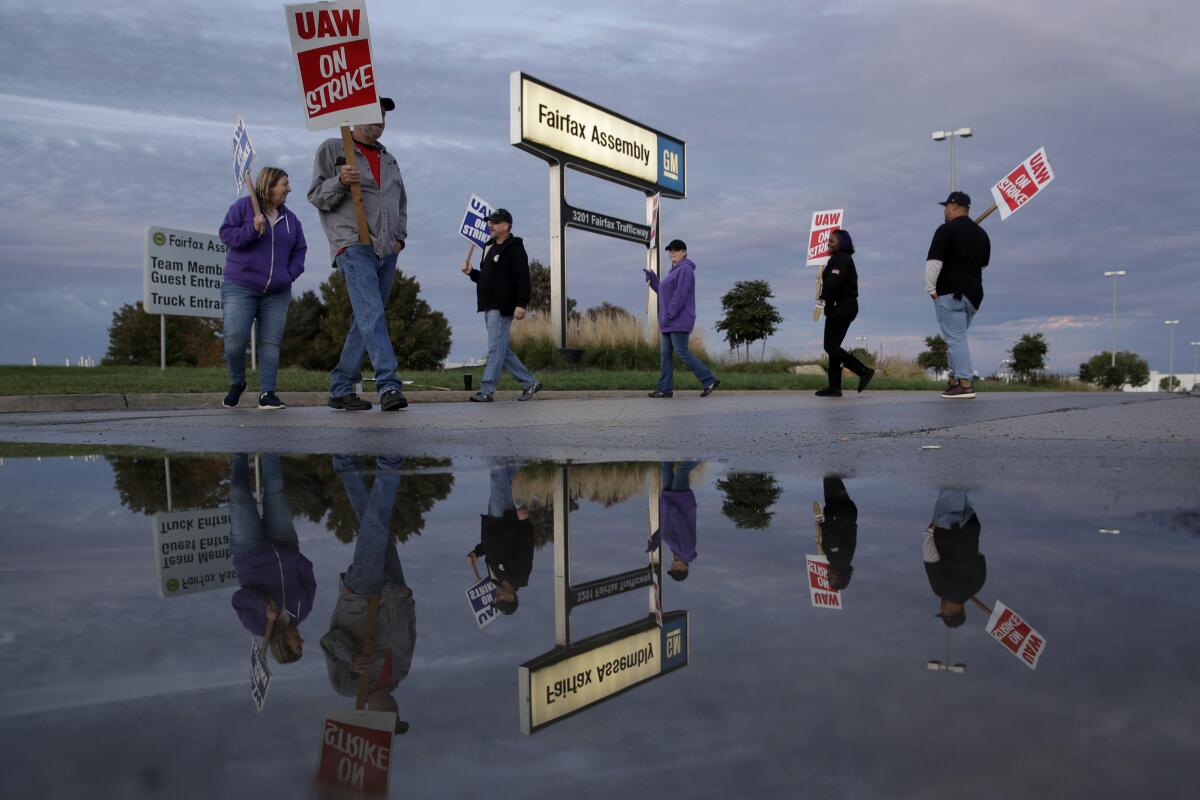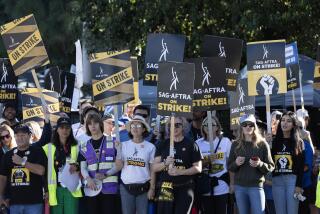GM strike hits broader economy, skewing recession-forecast data

As a result of the General Motors strike, more than 100 of the auto maker’s suppliers have laid off as many as 12,000 of their own workers, according to an industry trade group.
- Share via
The largest U.S. labor strike in a decade is starting to ripple through the nation’s economy, with the potential to weaken data on manufacturing and jobs that economists are scrutinizing for signs of a recession.
Now in its fourth week, the walkout of 48,000 General Motors workers has forced the shutdown of 34 plants across the United States. That is already showing up in weekly jobless claims and will lower the Labor Department’s payroll figures for October, according to economists. It may also weigh on the monthly manufacturing surveys and production numbers. The biggest, and hardest to predict, is the risk of spillover into consumer confidence and spending, which accounts for nearly three-quarters of growth.
The effects of the strike are exacerbated in an economy already facing systemic issues, including slowing manufacturing as companies step down investment amid uncertainty caused by the U.S.-China trade war and global slump. Although economists expect the strike’s effect to be temporary, deterioration in economic reports would create challenges for forecasters, who see a 35% chance of recession over the next 12 months.
“It’s a vulnerable picture, and the strike adds to the bucket of risks and volatility that the consumer is looking at,” said Julia Coronado, president of MacroPolicy Perspectives, an independent research firm. “The risks are just stacking up, and when you get an accumulation of risks stacking up, sometimes they can feed on each other.”
In an effort to end the strike, this week GM boosted its offer to the United Auto Workers union by about $2 billion, pledging $9 billion of investment in U.S. plants, according to a person familiar with the matter. On Friday, the union issued an open letter accusing GM of stalling negotiations to “starve UAW-GM workers off the picket lines” and protect its own interests.
Effects of the strike could also create noise in the data that’s “going to make it harder to get a sense of how the manufacturing sector is holding up,” said Sarah House, senior economist at Wells Fargo & Co. “It could make it hard to determine how much momentum the economy is losing right now.”
The clearest effect so far is in the labor market: The striking workers make up only about 0.03% of total employment in the United States but may have played a role in bumping up jobless claims for three straight weeks. Claims rose in states most reliant on auto production — including Michigan, Tennessee, and Indiana — though benefit filings declined nationally in the most recent week. Although most state laws prevent striking workers from getting unemployment benefits, they can still file, which is reflected in the count.
As a result of the stoppage, more than 100 of GM’s suppliers have laid off as many as 12,000 of their own workers, including truckers, parts makers and suppliers, according to the Original Equipment Suppliers Assn., an industry trade group. Less tangible is the slowed business at local restaurants, cafes and retailers.
While total car production makes up only about 0.8% of gross domestic product — and GM accounts for about a fifth of that — the strike likely reduced manufacturing output by 0.4 of a percentage point last month and may have a similar effect this month, according to Capital Economics. As a result, factory output probably declined 0.5% in September from the prior month, the group said in a research note.
“Cuts in this sector will likely continue to rise, especially if the strike at General Motors continues and the fallout impacts suppliers,” wrote Joshua Shapiro, economist at the research firm MFR.
The overall effects likely won’t show up in GDP until the fourth quarter of this year, because workers walked off the job mid-September. It’s already forecast to be one of the weakest quarters in recent years, with an annualized GDP growth rate of 1.7%, according to a survey of economists by Bloomberg News.






